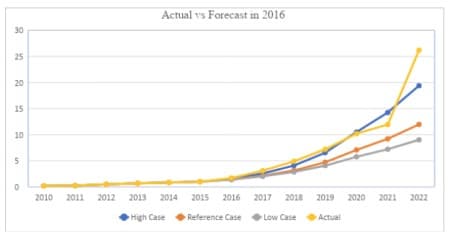As of 2022, the global car count stood at approximately 1.474 billion, with electric vehicles (EVs) accounting for 1.76%. The rise of EVs is increasingly being seen as a potential challenge to the future of the oil industry.
Asia has the world's largest concentration of cars, accounting for 36.8% (543 million vehicles) and consuming 35.7% of the daily 100.255 million barrels in 2022. Europe and North America follow, with Europe having a car population of 413 million and North America 358 million. Interestingly, while Europe boasts the second-largest number of vehicles, its oil consumption is significantly less than that of North America.
Two main reasons account for this:
- European vehicles are generally smaller and more fuel-efficient, and trips tend to be shorter.
- North America's cargo vehicles, which traverse long distances, are numerous and guzzle more fuel.
EVs, having been on the periphery since 2010, started showing potential for significant industry impact by 2022. With 26 million EVs worldwide, transportation trends are evidently shifting. This shift is powered by technological innovations, environmental awareness, governmental policies, and the evolution of EV charging infrastructure.
In 2016, the “Energy Post” published an article titled "Wake up call for oil companies: electric vehicles will deflate oil demand" Fast forward to a post-Covid world, and the automobile industry, recovering from global economic shocks, is veering more aggressively toward EVs.
As you can see in the chart below, the actual sales data for EVs and the predictions set forth in alternative 2016 scenarios. Up until 2021, the high-case prediction closely mirrored the actual sales numbers. However, 2022 took the industry by surprise, witnessing a record-breaking surge in EV sales — an impressive jump of over 14 million. This upward trajectory pushed total electric car sales to 26.2 million in 2022, up from 12 million in the previous year. Remarkably, EVs made up 14% of all new car sales in 2022, a significant increase from 9% in 2021 and a mere 5% in 2020.

The global electric vehicle (EV) market is primarily driven by three major players. China stands at the forefront, contributing to a staggering 60% of global EV sales. As a testament to its rapid adoption, over half of the world's electric cars now traverse China's roads. Impressively, China has surpassed its 2025 goal for new energy vehicle sales ahead of time.
Europe, coming in second, saw its electric car sales surge by over 15% in 2022. This means that for every five cars sold in Europe, one was electric. The U.S., although third in line, experienced a notable 55% boost in its EV sales during the same year, capturing 8% of the country's total car sales.
The global trend is promising, with EV sales set to maintain their momentum. In the first quarter alone, sales topped 2.3 million, a 25% increase compared to the previous year. By the close of 2023, the projection stands at a cumulative 40 million electric cars worldwide.
While the drive toward EV adoption is fueled by soaring oil prices and growing environmental concerns, high-oil-importing nations find themselves in a favorable position. However, a challenge they must confront is the prevalent electricity shortfall.
Given the dynamic state of electric vehicle (EV) adoption, it's crucial to regularly revise our models. This article endeavors to predict the number of EVs up to 2040 based on three divergent scenarios. Subsequently, we aim to gauge the potential reduction in global oil demand resulting from EV expansion.
Assumptions and Methodology:
Our assumptions pivot around the average oil consumption as of 2022 and the prevailing number of internal combustion engine (ICE) cars.
We assume that the transport sector accounts for 60% of global oil consumption. For instance, Asia's oil consumption in 2022 was 35.7 MMBD, of which 21.42 MMBD (60%) was attributed to transport. Other regions followed a similar method.
The global daily average oil consumption per car is estimated at 1.544078 gallons. Regional averages vary based on factors such as vehicle type, travel habits, fuel efficiency, and infrastructure. In 2022, the figures were: Asia at 1.6567, Europe at 0.89, North America at 1.73, and the rest of the world at 1.89 gallons/day/car.
Forecasting the Future
Here you can see the projected EV adoption based on our scenarios:

Projections are largely shaped by recent trends over distant historical data.
Initial assumptions have higher growth rates, decreasing by 20% every five years as the base expands.
Under the standard model, we anticipate an average annual EV sales growth of 20%, spiraling from 26.2 million in 2022 to 582 million in 2040. This projection accounts for current EV data and auto industry strategies, especially in high-growth markets like China and India.
This table shows the fuel-saving projections from 2016 to 2023:

Comparing Forecasts:
This table contrasts the EV and fuel-saving projections from 2016 with those of 2023:

In our updated study:
- The standard forecast estimates fuel savings of 21.42 MMBD in 2040, a significant leap from 13.8 MMBD in 2016.
- For our optimistic scenario, we project an annual growth rate of 23.4%, culminating in 937 million EVs by 2040. This differs from the 1.188 billion forecasted in 2016, mainly due to a reevaluation of assumptions post the unforeseen COVID-19 pandemic, resulting in fuel savings of 34.46 MMBD by 2040 compared to 38.9 MMBD previously.
- The conservative estimate anticipates an annual growth rate of 14.34%, resulting in 254 million EVs by 2040, and a potential fuel-saving of 9.36 MMBD.
The Potential Impact of EVs on the Global Oil Market
Forecasting based on alternative scenarios suggests that our projections will most likely fall between the reference and high-case scenarios. Given this, the ascendancy of the EV industry seems poised to command a significant portion of the future internal combustion engine (ICE) market.
Considering the ever-changing landscape of both the oil and automotive industries, it's prudent to reassess our assumptions every five years. Factors like updated data, evolving consumer preferences, and automotive industry strategies should be weighed in these evaluations.
Looking towards 2040, one pivotal question emerges: How will the projected penetration of EVs and consequent fuel displacement impact the global oil sector? If fuel displacement aligns with our reference to high-case scenarios, it could ring alarm bells for the global oil and gas industry. This is especially true for nations heavily reliant on oil export revenues.
While these analyses serve as early warnings, they also offer the oil industry ample time to strategize. By 2040, even with the rise of EVs, global oil demand may still hover between 65-78 MMBD, a decline from 100 MMBD in 2022. As a result, intense competition for market share might lead to price wars. In such scenarios, ICE vehicle owners and other industrial consumers stand to benefit the most.
By Salman Ghouri for Oilprice.com
More Top Reads From Oilprice.com:
- 50 Shades Of Green: European Impact Investing Explained
- New Catalyst Paves Way For Green Methane Production
- Transition Tension: Greenlash Wave Jeopardizes Energy Reform



















by that time 9.0 Billion people on earth.
115m bpd required
Good luck.